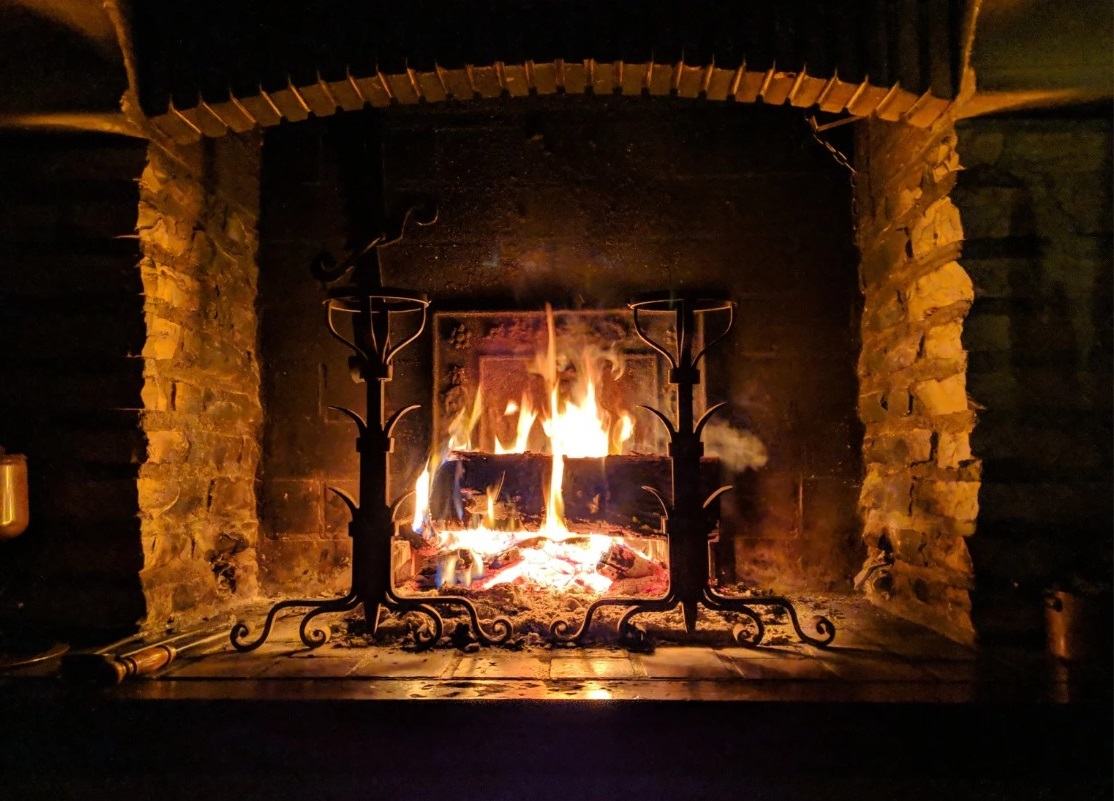Fireplaces, also called hearths, are a popular feature in many homes, adding warmth and charm to a space. Explore the various types of fireplaces available, such as traditional wood-burning, gas, electric, ethanol, and gel fireplaces. We will delve into the different types of fireplaces, the advantages of having one in your home, and the various terms used to describe this cozy focal point.
Discover more about this beloved fixture that offers comfort and style.
What is a Fireplace?
A fireplace is a central architectural feature intended to provide warmth and create a cozy atmosphere in a living space, typically found in areas such as the living room, den, bedroom, or kitchen.
A fireplace serves as a versatile design element that combines traditional charm with modern functionality, offering not only warmth but also a focal point for a room. Fireplaces come in a variety of types, including wood-burning, gas, electric, and even ethanol fireplaces, each contributing a unique style to an interior design. Whether it’s a classic brick fireplace in a rustic setting or a sleek, contemporary wall fireplace in a modern home, these fixtures play a crucial role in defining the tone and style of a room.
fireplace, a place to light an open fire in the house, used for heating and often for cooking. The fireplace first developed when medieval houses and castles were equipped with chimneys to exhaust smoke; experience soon showed that a rectangular shape was superior, that a certain depth was best, that a grate provided better draft, and that flared sides increased heat reflection. Early fireplaces were constructed from stone, while brick became a more commonly utilized material later on. A medieval discovery revived in modern times was that a thick stone wall opposite the fireplace was able to absorb and radiate heat back.
While the exact birth date of the fireplace is unknown, it has been used for thousands of years, beginning in the Stone Age as a simple dug-out hole. In the past, the fireplace was a necessity, serving as the center and main source of heat for the home and relied upon for cooking and baking. Now in the 21st century, the fireplace still serves as a source of heat and continues to bring families together but has become more of a luxury in modern homes.
From ancient times, fireplace accessories and furnishings have been objects of decoration. Since at least the 15th century, the hearth, a cast iron slab, protected the back wall of the fireplace from intense heat; it was usually decorated. After the 19th century, the hearth was replaced by firebrick in fireplace construction.
During the Medieval period, the fireplace was built in the center of the room. Smoke escaped through a hole cut in the ceiling above it. Beginning in the 11th century, two-story homes became more common. With this design change, homeowners moved the fireplace to the outside wall. This development eventually led to the creation of the contemporary chimney.
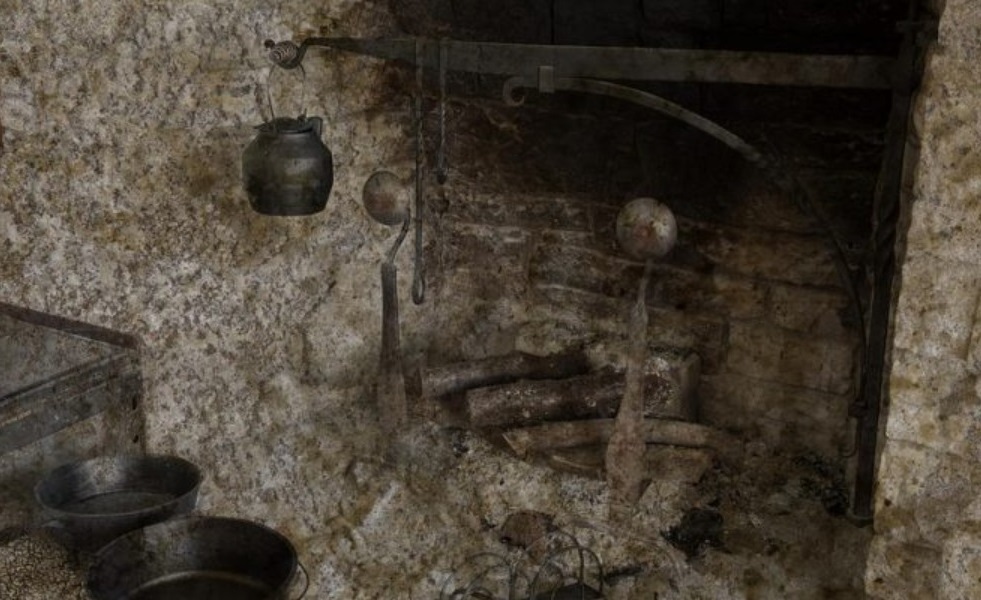
Andirons, a pair of horizontal iron bars on short legs and placed parallel to the sides of the fireplace to support burning firewood, were used since the Iron Age. The vertical guard bar at the front, placed to prevent firewood from rolling into the room, was often richly decorated. The rear guard bar was in use until the 14th century, after which the open central hearth as a heating device fell out of common practice. The grate, a type of cast iron grill basket, was introduced in the 11th century and primarily served the purpose of holding coals.
The fire equipment used to maintain the fire has changed little since the 15th century: tongs were used to handle the burning fuel, a fire fork or wood fork to guide the fuel into position, and a long-handled brush to keep the fire clean. The poker, designed to break up the embers into smaller pieces, was not widely used until the 18th century. Coal holders appeared in the early 18th century and were later adapted into decorative wooden boxes or racks for firewood. Fire screens were developed in the early 19th century to prevent sparks from flying into the room, and have also been decorated and shaped to serve both decorative and functional purposes.
The fireplace itself did not undergo any significant improvements after the open central hearth was abandoned until 1624, when Louis Savot, an architect working on the Louvre in Paris, created a fireplace that drew air through passages beneath and behind the hearth and released it into the room through a grate in the mantelpiece.
In the 1600s and early 1700s, fireplaces were generally wide and deep with an open alcove and were typically designed without a mantle. In the 1740s, Benjamin Franklin invented the Franklin Stove, a cast iron design that produced more heat and was placed in the center of the room. After the War of Independence ended in 1783, the fireplace became the focal point of the home, featuring a mantel and surround with decorative elements such as rope weaving, floral decorations, and star and shell accents. In 1796, Sir Benjamin Thompson, also known as Count Rumsford, designed a new style of fireplace that lasted until the 1900s and served as the basis for all fireplaces today. The design was taller than it was wide, narrower and shallower with a sharp-angled recess on either side. The narrow throat design also facilitated faster dispersion of smoke and air.
In the mid-1800s, as more homes burned coal instead of wood, there was a shift to the horseshoe-shaped cast iron style. A more ornate fireplace design emerged in the Victorian era in 1837, featuring a mantle and columns and including the first cast iron-insert combination. The legs around the base were also adorned with decorative tiles.
This approach was adapted in the 20th century to the prefabricated double-walled steel fireplace mantel with hollow walls that act as air passages. Some of these systems utilize electric fans to promote circulation. In the 1970s, when sharply rising fuel costs prompted energy conservation measures, closed systems were devised in which air to support combustion was drawn from outside the house or from an unheated part; a glass cover, fitted tightly over the front of the fireplace, was sealed after the fuel was placed and lit.
What Are the Different Types of Fireplaces?
Fireplaces are available in various styles, each offering unique characteristics and design elements that cater to different heating preferences and needs.
Traditional Wood-Burning Fireplaces
Traditional wood-burning fireplaces evoke a sense of nostalgia and classic charm, using logs and a chimney to create a crackling fire that adds to the cozy ambiance of a home.
The mechanics of a traditional wood-burning fireplace are simple and effective. The logs are carefully arranged inside the fireplace, and once lit, they create a show of dancing flames and mesmerizing warmth. Proper ventilation through the chimney is crucial to ensure that smoke and harmful gases are safely directed to the outside.
The sound of a crackling fire adds an element of comfort and relaxation to any room, inviting people to gather and relax. Fireplace maintenance includes regular chimney cleaning to prevent soot buildup and ensuring the fireplace is in good condition. Safety considerations such as using a fireplace screen to prevent sparks and embers from escaping are essential. Despite advances in heating technology, the timeless appeal of the traditional wood-burning fireplace in interior design remains appreciated for its rustic charm and cozy ambiance.
Gas Fireplaces
Gas fireplaces offer a convenient and efficient heating solution for modern homes, using gas as a fuel source to provide warmth and ambiance without the need for traditional wood burning.
With a gas fireplace, users can easily control the flame height and heat output with the push of a button or turn of a knob, providing instant warmth at the desired level. These fireplaces eliminate the mess associated with handling logs, such as cleaning out ash and smoke residue.
In terms of safety, gas fireplaces come with features such as automatic shutoff valves and flame sensors, providing users with peace of mind. The installation process for a gas fireplace is typically easier than wood-burning options, often requiring less construction and in some cases not requiring a chimney or flue system.
Maintenance requirements are also minimal, with regular inspections of the gas logs and venting components to ensure optimal performance. Gas fireplaces are available in a variety of designs ranging from sleek modern units to traditional models, allowing homeowners to find the perfect style to complement their interior decor.
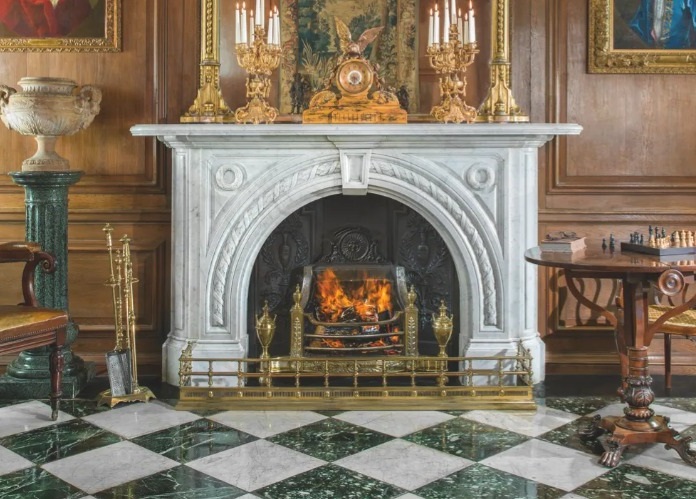
Electric Fireplaces
Electric fireplaces offer a flexible, energy-efficient heating solution that can be easily incorporated into various home decor styles, providing warmth and ambiance at the push of a button.
These innovative heating options come in different designs, such as modern units or traditional fireplace styles, allowing them to perfectly match the look of any room. By operating with a simple plug-in, electric fireplaces eliminate the necessity for gas lines or vents, making them a convenient choice for installation.
The gentle glow of lifelike LED flames creates a cozy atmosphere without the upkeep of a traditional wood-burning fireplace. Whether they are mounted on a wall, placed on a TV stand, or freestanding, these fireplaces become a focal point in any space.
Ethanol Fireplaces
Ethanol fireplaces provide a modern, eco-friendly heating option that adds a contemporary touch to any living space, using bioethanol fuel to produce a clean, smoke-free flame.
The clean-burning nature of ethanol fireplaces makes them a popular choice for environmentally conscious homeowners looking to minimize their carbon footprint. Their versatility in placement allows for easy installation in various locations, whether as a centerpiece in the living room or a cozy addition to a bedroom.
In addition to their functionality, ethanol fireplaces also contribute to stylish interior decor, blending seamlessly with modern or eclectic design schemes. The installation process for these fireplaces is typically hassle-free, requiring no chimney or special ventilation, making them a convenient option.
Routine maintenance simply involves ensuring an adequate fuel supply and keeping the burners clean for optimal performance. Their presence in the home creates a unique ambiance, providing a comfortable place to unwind after a busy day.
Gel Fireplaces
Gel fireplaces offer a portable, straightforward heating option that creates a cozy, inviting atmosphere in both indoor and outdoor spaces, using a canister of gel fuel to generate warmth and a gentle flame.
These versatile fireplaces are ideal for apartments, homes, patios, and even vacation cabins, as they do not need a chimney or vent. The clean-burning, odorless, and environmentally friendly gel fuel used in these fireplaces makes them a popular choice for those seeking a sustainable heating solution.
With a range of sleek, modern designs available, gel fireplaces can blend in with any decor style while also serving as a focal point of the room. Whether you want to create a romantic ambiance in your living room or add warmth to an outdoor gathering, gel fireplaces offer both functionality and style.
Why Add a Fireplace to Your Living Room?
Fireplaces are charming. There’s nothing more heartwarming than welcoming your guests into your home with a beautiful fireplace in the living room. Therefore, it’s no surprise to see fireplaces in homes on the big screen and regular TV shows. But aside from their aesthetic appeal and frequent appearances in the media, what else can a fireplace offer to a home? Is it worth considering the addition of one to your home? Here are some reasons why!
Benefits of Incorporating a Fireplace into Your Home
Reduce Heating Costs
With the rise of home heating systems, fireplaces are now considered for practical purposes. Well, if you can heat your home with the simple flick of a thermostat, why not?
Compared to other heating systems, fireplaces are a cost-effective option. Heating systems consume so much electricity and power. In the winter, for example, heating a room can run into thousands of dollars in utility bills. However, having a dedicated fireplace that is big enough to warm your home is reason enough to not touch the thermostat. Plus, dedicated fireplaces are also great for reducing the heat in your home because they require less energy. Wood isn’t expensive enough to outweigh the cost of a heating system. Wood is even more cost-effective at normal temperatures when you just want a little warmth.
Cozy Up a Room
Have you ever noticed how a fireplace affects the ambiance of a room? Whether it’s a fireplace wall design or a fireplace wall decor, a fireplace has a calming appeal.
The old-school design of a fireplace provides a rustic feel that can boost one’s mood. Fire, with its warmth, is known to soothe and calm the body. For cold or cloudy nights, a fireplace makes a room feel cozy and warm. Imagine spending the night cuddling up with your loved one on the couch by the fire. Just the thought of it creates a very calming experience.
Adds Value to Your Home
Not many individuals are aware of this, but installing a fireplace is a cost-effective home enhancement that will boost the value of your property. The installation of a fireplace can range from five thousand dollars or more, but it can significantly impact the value of a home. Similar to any fixture with its own advantages, a fireplace provides unique benefits. Whether it is a gas, wood, or electric fireplace, the added advantage is the enjoyment of a secure space by the fire.
According to research conducted by the National Center for Real Estate, each fireplace increases the value of a home by 12%. This percentage can further increase based on the home’s location, climate, and other factors. Additionally, homes with fireplaces are attractive to many buyers due to their potential benefits and practicality.
Transforming Your Home
You do not need to settle for a standard fireplace. You can have a personalized fireplace designed to match the overall look you desire. Modern homes come in various styles and utilize common fireplaces. Some feature glass fireplaces, transparent structures, and even remote controls. With numerous designs to select from or the option to create your own, it is impossible not to be satisfied with a fireplace that meets your requirements and specifications. If you do not wish to use a fireplace, you can opt for fireplace wall decor. This decor adds a touch of elegance and sophistication to a living room. It also captures attention and serves as an excellent conversation starter! For an intriguing and unique fireplace, you can opt for a fireplace wall design. A fireplace wall design is a fireplace that is not situated on the floor but is mounted in the middle of a wall. This design adds an unconventional and modern twist to the traditional fireplace experience.
What Are the Benefits of Having a Fireplace?
Having a fireplace in your home offers a range of benefits beyond just providing warmth, including enhancing the atmosphere, serving as a focal point in a room, and adding a touch of aesthetic appeal to your living space.
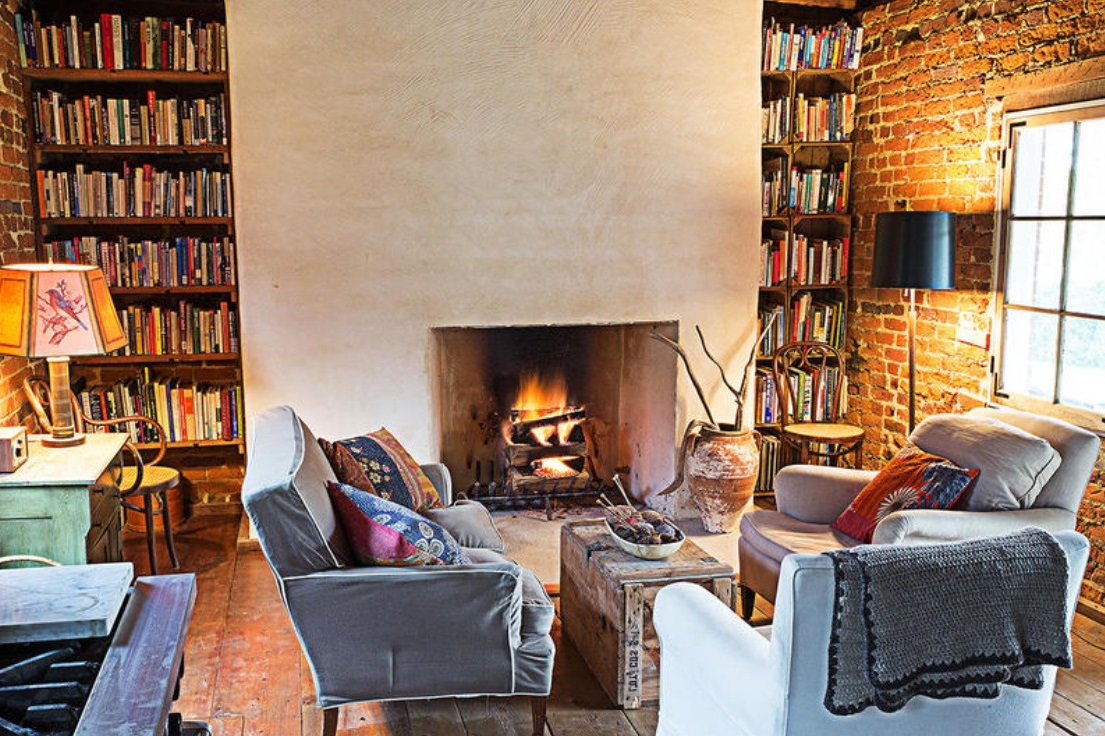
Provides Warmth and Coziness
One of the primary advantages of a fireplace is its ability to offer both physical warmth and emotional comfort, creating a cozy and soothing environment for its occupants. The sound of a crackling fire and flickering flames not only warm a room, but also add a touch of atmosphere that can instantly elevate the interior of a room. Fireplaces are often the focal point of a room, capturing attention with their radiant light and creating a sense of intimacy. In addition to their functional purpose, fireplaces contribute to a welcoming atmosphere that promotes relaxation and socializing, making them a key element in creating a cozy and inviting home.
Adds Atmosphere and Aesthetics
A fireplace acts as a focal point in a room, enhancing the overall atmosphere and aesthetic of the room through its design, materials, and visual appeal. The mantelpiece offers an excellent opportunity to showcase artwork, decorative items, or family photographs, as well as adding a personal touch to the room’s decor. The fireplace area can be adorned with stylish fireplace accessories, cozy rugs, or a collection of firewood, further enhancing the cozy ambiance. Surrounding the fireplace with decorative tiles, stone, or sleek wood paneling can complement the color scheme and architectural style of the room, making the fireplace a striking visual centerpiece that exudes warmth and charm.
Can Be Used as a Backup Heat Source
In addition to the primary heating system, a fireplace can serve as an effective secondary heat source during the colder months, providing warmth and comfort in the event of a power outage or as an additional heating option. The heat generated by a fireplace not only provides a reliable source of warmth, but also creates a cozy atmosphere that is both inviting and calming. During emergencies or when traditional heating systems are unavailable, the sound of burning wood and flickering flames can provide a sense of comfort and security for occupants. The versatility of a fireplace as an alternative heating element in a household adds an extra layer of comfort, allowing individuals to maintain a comfortable temperature even in the face of unexpected circumstances.
Increasing Home Value
A fireplace is considered an attractive feature in a home, adding value and overall appeal to a property through its visual charm, cozy warmth, and potential to enhance interior design.
A fireplace can significantly affect a property’s value, making it a strategic addition for homeowners aiming to boost the market appeal of their home. When potential buyers see a home with a fireplace, they are often attracted to the center of attention it creates in the living room, imagining cozy evenings in with loved ones. Renovation projects that involve adding or upgrading a fireplace can result in a substantial return on investment, as buyers are willing to pay more for homes that offer this specific feature.
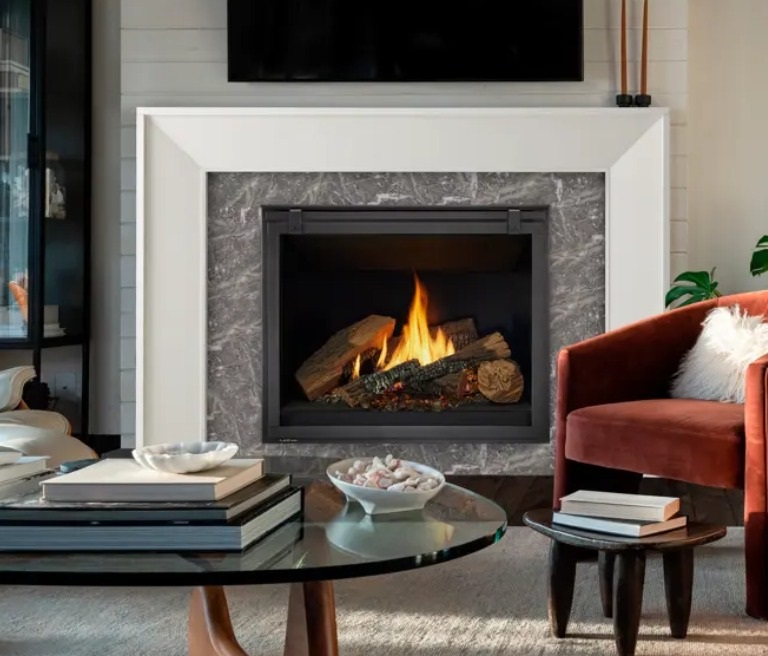
What Are the Different Names for a Fireplace?
A fireplace is known by various names that demonstrate its different components and design elements, such as a hearth, mantel, chimney, and fire surround, each of which contributes to its functionality and visual appeal.
Fireplace
A hearth is the area directly in front of the firebox, usually made of brick, stone, or other heat-resistant material, that serves both a functional and decorative purpose within the overall design of the fireplace.
A fireplace provides a safety feature by creating a protective barrier between the fire and the surrounding floor or walls, preventing accidental fires or heat damage. In addition to its practicality, a fireplace is often the focal point of a room, enhancing the visual appeal of the space.
With a range of design options, from classic brick fireplaces to sleek modern styles, homeowners can select a fireplace that complements their overall interior decor. The cozy ambiance created by a roaring fire in the hearth area adds warmth and charm to any living space, inviting relaxation and gathering around its soothing glow.
Firebox
The firebox is the enclosed space inside the fireplace where the fire burns, and it determines the type of fuel that can be used, such as wood in a traditional fireplace or gas in a modern gas fireplace.
In wood-burning fireplaces, the firebox is typically constructed of firebrick or durable fireproof panels to withstand the high temperatures produced by burning wood. Proper ventilation is essential in a wood-burning firebox to ensure efficient combustion and reduce the risk of smoke entering the living space.
On the other hand, gas fireplaces have fireboxes designed for gas burning, which emphasizes fuel efficiency and comfort. The heat radiated from the firebox creates a cozy atmosphere, making it a focal point in any room. The design and functionality of the firebox have a significant impact on the performance and comfort of different types of fireplaces.
Mantels
A mantel is a shelf or decorative structure that sits above the firebox. It is often used to display artwork, photographs, or seasonal decorations. Mantels add a personal touch to a fireplace design.
Mantels play an important role in enhancing the overall visual appeal of a room. They also serve as a focal point that can reflect the homeowner’s style and taste. Traditional mantels are often made of wood, which offers a classic and elegant look. In contrast, modern designs may feature sleek metal or stone materials for a more contemporary feel. Mantels provide a canvas for creativity, allowing individuals to incorporate elements to further personalize their living space. These elements include clocks, candles, mirrors, or even plants.
Chimney
A chimney is a vertical structure that rises above the fireplace to exhaust smoke, gases, and combustion byproducts. The chimney plays a vital role in maintaining indoor air quality and ensuring the fireplace operates safely.
In addition to ventilation, the chimney also serves an important safety function. The chimney directs harmful gases such as carbon monoxide away from the living space. A properly designed and functioning chimney can prevent the buildup of toxic gases inside the home. The chimney protects the occupants from potential health hazards.
In terms of indoor air quality, the chimney helps minimize the presence of pollutants by expelling them to the outdoors. Materials commonly utilized in the construction of chimneys are brick, stone, and metal. Each offers different benefits in terms of durability and resistance to heat.
Routine maintenance is essential to keep the chimney functioning efficiently and prevent potential hazards. Routine maintenance includes cleaning and inspection. Potential hazards can lead to chimney fires. Whether in a traditional open fire or a modern wood stove or gas fireplace, the chimney remains an integral component. The chimney contributes to the overall comfort and safety of the home.
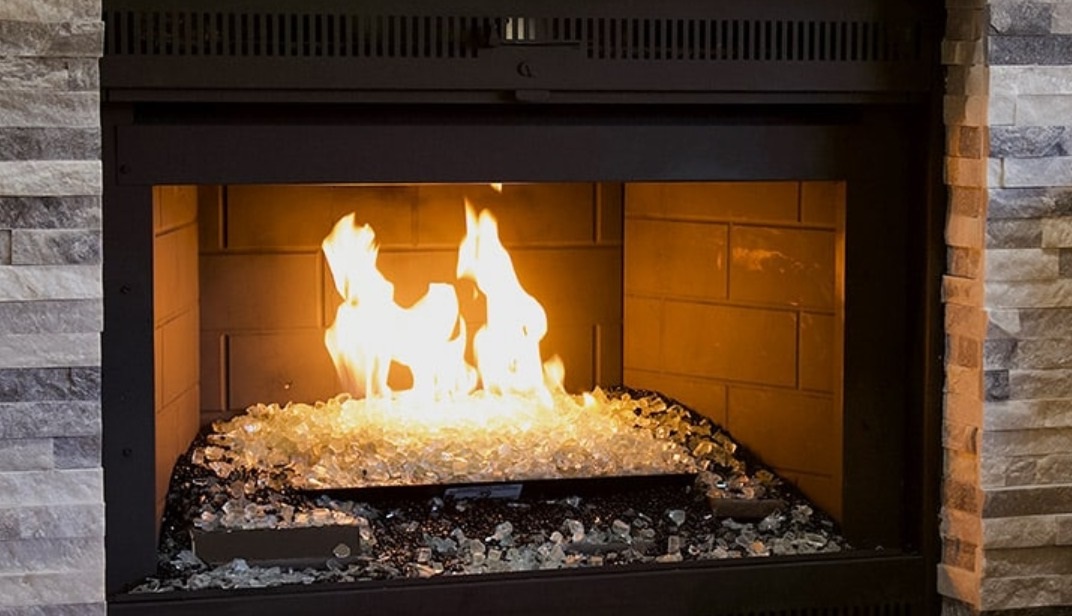
Chimney
A chimney functions as the passage within a fireplace that allows smoke and gases to exit. Regular maintenance and inspections are necessary for proper ventilation and safe fireplace operation.
Neglecting chimney upkeep can result in the accumulation of creosote and debris, increasing the risk of a chimney fire. It is crucial to conduct regular inspections, cleanings, and safety checks to prevent these hazards. Chimney inspections involve examining for blockages, cracks, and proper damper function. Cleaning procedures typically entail removing soot and creosote deposits using specialized brushes and vacuum equipment. Ensuring the chimney’s good condition is vital for maintaining indoor air quality and efficient fireplace performance.
Grate
A grate is a metal or cast iron structure that holds fuel above the firebox’s bottom, allowing air to circulate and promote efficient combustion for a comfortable fire. By elevating the fuel source, a fireplace grate ensures that airflow can reach the firewood from below, facilitating a steady and even burn. This design not only helps prevent smoldering but also reduces smoke emissions.
Traditional fireplace grates usually feature sturdy construction with evenly spaced slats to support the wood. On the other hand, modern styles may incorporate innovative designs to enhance efficiency and aesthetic appeal. Whether you opt for a classic or contemporary grate, the function remains the same, enhancing the warmth and ambiance of your wood-burning fireplace.
Hearthstone
A hearthstone, or hearth, is the floor area in front of the fireplace that extends into the room, providing a protective and decorative element that enhances the cozy atmosphere created by the fire.
The hearthstone serves as a multi-purpose space, shielding against unwanted embers and sparks while also playing a significant role in determining the overall fireplace aesthetic. Craftsmen fashion hearthstones from a variety of materials such as natural stone, brick, tile, or even metal, each offering a unique texture and color to complement the room’s design.
The modern interpretation of the hearthstone has evolved to include sleek and minimalist designs, blending into contemporary interior styles while still serving its primary purpose of security and charm.
Fire Surrounds
A fireplace surround, also known as a fireplace casing, is a decorative structure that frames the firebox and mantel, enhancing the visual appeal of the fireplace and serving as a focal point in the room, setting the overall mood of the space, whether it’s a cozy living room, a luxurious master bedroom, or a rustic cabin.
Fireplaces come in a variety of styles, from traditional ornate designs to sleek, modern interpretations, offering endless possibilities to complement a variety of interior decorating themes. You can use materials to craft your fireplace surround, each adding a unique texture and finish to the room, such as marble, cast stone, wood, or metal. The choice of materials and finishes can significantly impact the aesthetics of the fireplace surround, adding warmth and charm to the area.
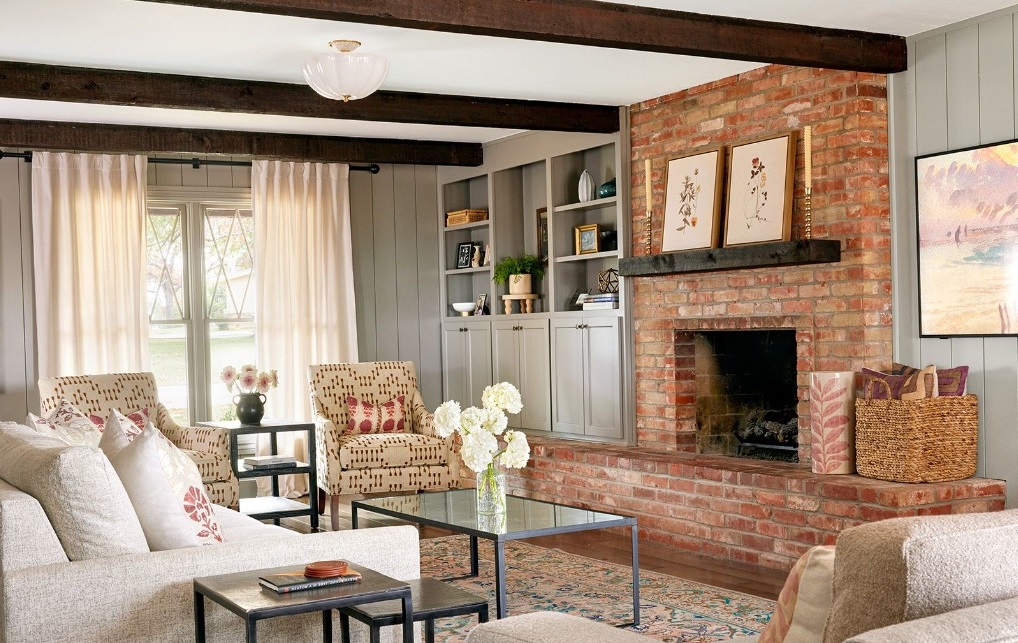
Frequently Asked Questions
- What is another name for a fireplace?
A fireplace is also known as a hearth and serves as a central feature in a home, adding warmth and charm to various living spaces such as the family room, den, and bedroom. A fireplace is essential during the winter, providing warmth to the room during snowy weather.
- What are the types of fireplaces available?
Various types of fireplaces are available, including traditional wood-burning fireplaces, gas fireplaces, electric fireplaces, ethanol fireplaces, and gel fireplaces, each offering unique characteristics and design elements to meet different heating needs and preferences.
- What are the benefits of having a fireplace?
Having a fireplace provides warmth and comfort, adds ambiance and aesthetics, serves as a backup heat source, and increases the value of a home. Lastly, a fireplace serves as a focal point in a room.
- What are the names of a fireplace?
In addition to a fireplace, a fireplace may be referred to by various names that reflect its components and design elements, including mantel, chimney, firebox, flue, grate, hearthstone, and fire surround.
- What is the functionality of traditional wood-burning fireplaces?
Traditional wood-burning fireplaces operate by utilizing logs and a chimney to generate a fire, resulting in a warm and cozy atmosphere with crackling flames. Additionally, they necessitate a chimney to ensure proper ventilation for the expulsion of smoke and gases.
- How do gas fireplaces provide comfort and efficiency?
Gas fireplaces utilize gas as a fuel source to offer both warmth and ambiance without the requirement of firewood. They provide effortless flame control, demand minimal upkeep, and are equipped with safety characteristics, including an automatic shutoff valve for added peace of mind.
